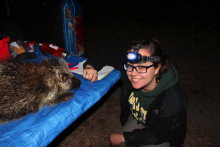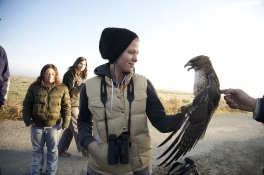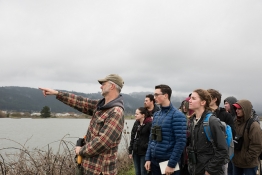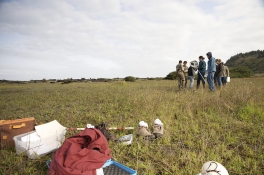William "Tim" Bean
Adjunct Professor
Spatial and landscape ecology, especially in rodents and other small mammals; uniting novel spatial methods in GIS and remote sensing with traditional field work to aid management; historical ecology and wildlife in the humanities; conservation science.
Education
Courses Taught
Research
Although wildlife management has evolved dramatically in the 80 years since the University of Wisconsin first hired Aldo Leopold, we are still, at root, interested in three basic questions he posed: what have we done to the land, what are we doing now, and what are the consequences of those actions in the future? My research combines time-honored field methods with novel modeling and experimental techniques to address each of those questions, focusing in particular on the disciplines of population, habitat, movement and historical ecology.
I am particularly interested in species distributions across spatial scales. Maxent and other statistical techniques have been developed to understand species’ Hutchinsonian and Grinellian niches. What those models really mean, whether they’re applicable at finer spatial or temporal scales, how they project into the future and past, what they say about population and community ecology, and whether climatic variables are the most meaningful limits to species ranges are all open questions that require careful study. While I am thrilled by the possibilities of using freely available spatial data to develop complex spatial models, my research focuses on the natural history and ecology of the species to better inform these modeling exercises.
Giant Kangaroo Rats
The giant kangaroo rat (Dipodomys ingens) is a state- and federally-listed endangered rodent found in the western San Joaquin Valley and adjacent Coast Range. The species is limited to a narrow band of mean annual precipitation of approximately 7”-12”, and to flat or gentle slopes with loamy soil. Although precipitation is low it is also highly variable: in recent drought years, rainfall has been almost non-existent. In wetter El Nino years the area can receive up to 20”. This precipitation dynamic presents interesting and unique opportunities to study a population (and community) in a highly variable resource setting.
The recovery plan for giant kangaroo rats has clear, achievable goals. Our work incorporates range-wide surveys as well as a more intensive focus on the Ciervo-Panoche population, where approximately half of the remaining habitat is on private lands and some is slated for solar power development. Key questions about this population remain, including a better understanding of metapopulation dynamics and local adaptation to climate change (and the ability of niche models to tease that apart). My current funding includes opportunities for genomic studies in collaboration with the Sacks lab at UC-Davis and work on range-wide population dynamics and survey design.
White-footed voles
White-footed voles (Arborimus albipes) are one of the least studied small mammals in the United States. They are either very rare or very hard to catch. Occupying coastal habitat in northern California and Oregon, this species is semi-arboreal and apparently closely tied to stands of red alder. Little is known about the ecology of this species, and we are actively working on improving detection techniques and establishing baseline demographic data in a population in northern Humboldt County. Ongoing work includes intensive live-trapping in an old-growth coastal conifer stand and extensive trapping throughout coastal northwestern California in Mendocino, Humboldt and Del Norte Counties.
North American porcupines
In contrast to the habitat specialists above, North American porcupines are an incredible example of a generalist herbivore. Found throughout the continent, from New England to Alaska and south into Mexico, porcupines offer an exciting opportunity through collaboration or meta-analysis to understand range limits in a generalist species. In the summer of 2015, we initiated a radio- and GPS-collar study of a robust population in Tolowa Dunes State Park. Very little is known about the natural history of this species in a dune forest community, and even less is understood about the species in California. Recent work in the southern Sierras and northwest California has suggested a decline but without a single clear cause. Depending on funding, future work could include a better understanding of movement, parentage, dispersal, diet and energetics within the Tolowa population or more extensive surveys throughout the region to understand limiting factors, demographics, and threats to the population.
Novel technological solutions
The past decade has seen an incredible explosion of new technologies and cost decreases in existing ones. GPS collars, now costing $2-$3k, can be hacked using consumer-level equipment for $200-$300. Unmanned aerial vehicles can provide three-dimensional imagery at incredibly fine spatial and temporal scales. We currently are focusing on the use of “drones” to monitor waterbird populations and to develop a rapid response system in the event of an oil spill. Ecology is about to experience an observational revolution on par with the astronomical revolution 500 years ago. Inexpensive, novel sensors combined with open access data will provide us with a flood of information. We are incorporating these approaches in the systems above, but understanding best practices for collecting and analyzing this data is a field unto itself.
Prospective Graduate Students
I am actively seeking new graduate students. If you have demonstrable experience in the field, and experience or interest in using GIS and remote sensing to improve wildlife management, please e-mail an introductory statement and your CV. I currently have an active research program on giant kangaroo rats in central California, and am establishing additional research on spatial ecology in northern California, including work with porcupines, white-footed-voles and mountain beaver, as well as protected area effectiveness. I would be thrilled to work with other taxa, but I am primarily interested in working with students whose research interests require a spatial component to their work.
Former Graduate Students
| Name | Thesis |
|---|---|
|
Adam Mohr 2020 |
Spatial ecology for two subspecies of elk in California Important spatial ecology questions remain unanswered for two subspecies of elk in California, the Roosevelt and tule elk. For my thesis work I’m studying how these unique elk populations balance the need for forage, water, predator avoidance, and respond to human land-use. I’ll be using a resource... Read Adam Mohr's bio |
|
Alyssa Semerdjian 2019 |
Evaluation of range-wide occupancy and survey methods for the giant kangaroo rat (Dipodomys ingens) After graduating from Cal Poly, SLO I worked for a couple of animal behavior studies before turning my attention to small mammal trapping projects. Small mammals make appealing study subjects due to their relatively large numbers and trapability. They play very important but understated roles in... Read Alyssa Semerdjian's bio |
|
Pairsa Belamaric 2019  |
Direct and/or indirect effects porcupine foraging may have on coastal dune forest ecosystems California’s north coast has long been home to the North American porcupine, but anecdotal evidence tells us populations are declining in this region. Being an understudied species in western coastal areas – very little is known about how porcupines use local resources or how extirpation may affect... Read Pairsa Belamaric's bio |
|
Sarah Schooler 2019 |
Shade trees preserve avian insectivore biodiversity on coffee farms in a warming climate |
|
Jennie Jones Scherbinski 2018 |
The influence of microclimate and local adaptation for a climate-sensitive species (Aplodontia rufa) My interest in wildlife conservation has been clear ever since founding the Endangered Species Club in the third grade. After completing my undergraduate degree at University of Colorado, Boulder, I pursued my interest in endangered species while spending 6 years working for the California Condor... Read Jennie Jones Scherbinski's bio |
|
Ivy Widick 2018 |
Evaluating current and future range limits of an endangered, keystone rodent (Dipodomys ingens) |
|
Nathan Alexander 2016 |
Genetic structure and connectivity of the endangered Giant Kangaroo Rat (Dipodomys ingens) in a heterogeneous environment |
|
Cara Appel 2016 |
Seasonal habitat selection of the North American porcupine (Erethizon dorsatum) in a coastal dune forest |
|
Sharon Dulava 2016 |
Fine-scale change detection using unmanned aircraft systems (UAS) to inform reproductive biology in nesting Waterbirds |
Publications
- Bean, W.T., D. Tange*, and S. Osborn. 2016. A suitability model for white-footed voles with insights into habitat associations at the southern boundary of their range. Northwestern Naturalist 97:105-112.
- Dulava, S., W.T. Bean, and O. Richmond. 2015. Applications of unmanned aircraft systems (UAS) for waterbird surveys. Environmental Practice 17:201-210.
- Bean, W.T., H.S. Butterfield, R. Stafford, and J.S. Brashares. 2014. Multi-step realized distribution models suggest bottom-up control of an endangered rodent. PLoS ONE 9:e106638
- Bean, W.T., L.P. Prugh, R. Stafford, H.S. Butterfield, M. Westphal, and J.S. Brashares. 2014. Species distribution models of an endangered rodent offer incomplete measures of habitat quality at multiple scales. Journal of Applied Ecology 51:1116-1125.
- Bean, W.T., R. Stafford, H.S. Butterfield, L.R. Prugh and J.S. Brashares. 2012. An evaluation of monitoring methods for giant kangaroo rats. Wildlife Society Bulletin 36:587-593.
- Bean, W.T., R. Stafford, and J.S. Brashares. 2011. The effects of small sample size and sample bias on threshold selection and accuracy assessment of species distribution models. Ecography 35:250-258.
- Prugh, L., C. Stoner, C. Epps, W.T. Bean, W. Ripple, A. Laliberte, and J.S. Brashares. 2009. The rise of the mesopredator. Bioscience 59:779-791.
- Wittemyer, G., P. Elsen, W.T. Bean, A.C. Burton, and J.S. Brashares. 2008. Accelerated human population growth at protected area edges. Science 321:123-126.
- Bean, W.T., and E.W. Sanderson. 2007. Using a spatially explicit model to test scenarios of fire use by Native Americans: an example from the Harlem Plains, New York, NY. Ecological Modelling 211:301-308.







